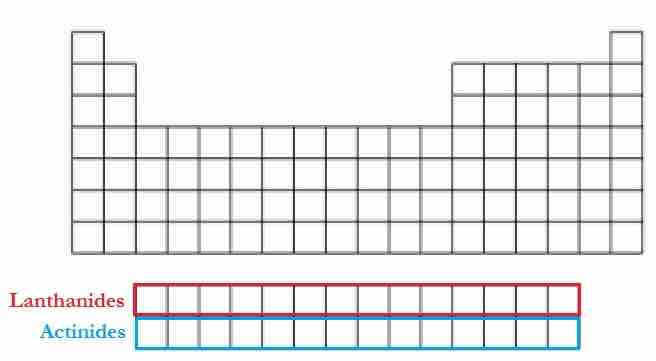The lanthanides and actinides form a group that appears almost disconnected from the rest of the periodic table. This is the f block of elements, known as the inner transition series. This is due to the proper numerical position between Groups 2 and 3 of the transition metals.

A blank periodic table showing the lanthanide and actinide series
The red highlighted group shows the lanthanide series and the blue highlighted group shows the actinide series.
Electron Configuration
The 14 elements (numbers 58 to 71) of the lanthanide series are also known as the rare earth elements. Most lanthanides are formed when uranium and plutonium undergo nuclear reactions. Atomic bombs charged with plutonium (actinoid) were used in World War II. Plutonium was a power source for Voyager spacecrafts launched in 1977 and is also used in artificial heart pacemakers.
The f sublevel contains seven orbitals, each of which will hold two electrons. Therefore, it is possible to place 14 electrons in the 4f sublevel. Generally speaking, the lanthanides have electron configurations that follow the Aufbau rule, and the 4f sublevel is filled as atomic number increases from cerium (Ce) to lutetium (Lu). However, there are three lanthanide metals that have properties similar to the d block: cerium (Ce), lutetium (Lu), and gadolinium (Gd). All of these metals contain a d electron in their electron configuration.
A similar overall trend holds for the 14 elements in the actinide series (numbers 90 to 103): from thorium (Th) to Lawrencium (Lr), the 5f sublevel is progressively filled.
Elemental Properties
The chemistry of the lanthanides differs from main group elements and transition metals because of the nature of the 4f orbitals. These orbitals are "buried" inside the atom and are shielded from the atom's environment by the 4d and 5p electrons. As a consequence, the chemistry of the elements is largely determined by their size, which decreases gradually with increasing atomic number. This phenomenon is known as the lanthanide contraction. All the lanthanide elements exhibit the oxidation state +3.
Actinides are typical metals. All of them are soft, have a silvery color (but tarnish in air), and have relatively high density and plasticity. Some of them can be cut with a knife. The hardness of thorium is similar to that of soft steel, so heated pure thorium can be rolled in sheets and pulled into wire. Thorium is nearly half as dense as uranium and plutonium but is harder than both of them.
Unlike the lanthanides, most elements of the actinide series have the same properties as the d block. Members of the actinide series can lose multiple electrons to form a variety of different ions. All actinides are radioactive, paramagnetic, and, with the exception of actinium, have several crystalline phases. All actinides are pyrophoric, especially when finely divided (i.e., they spontaneously ignite upon exposure to air).
The melting point of actinides does not have a clear dependence on the number of f electrons. The unusually low melting point of neptunium and plutonium (~640 °C) is explained by hybridization of 5f and 6d orbitals and the formation of directional bonds in these metals. Like the lanthanides, all actinides are highly reactive with halogens and chalcogens; however, the actinides react more easily. Actinides, especially those with a small number of 5f electrons, are prone to hybridization. This is explained by the similarity of the electron energies at the 5f, 7s, and 6d subshells. Most actinides exhibit a larger variety of valence states.